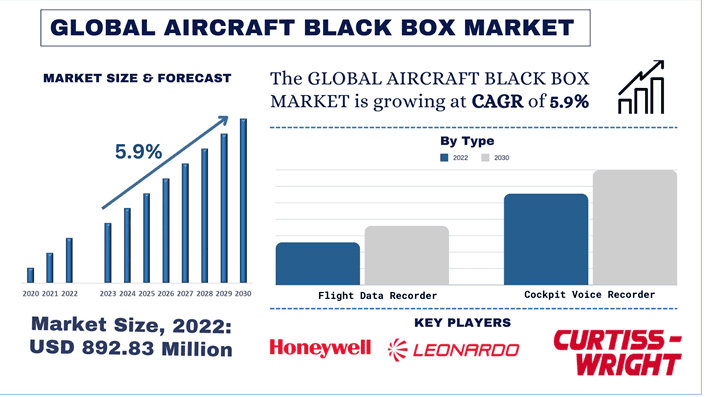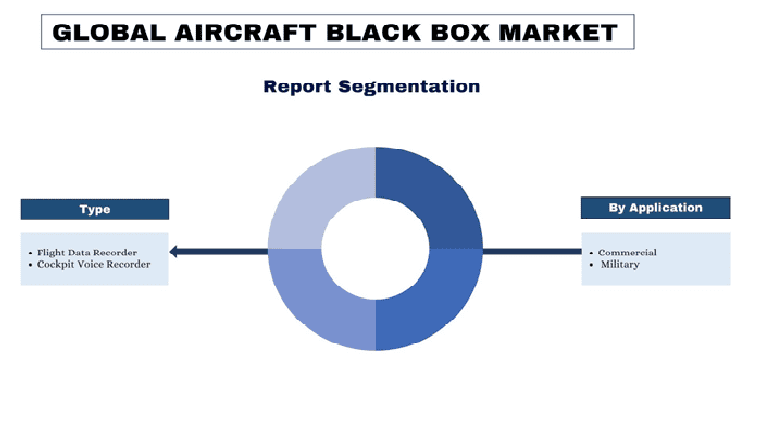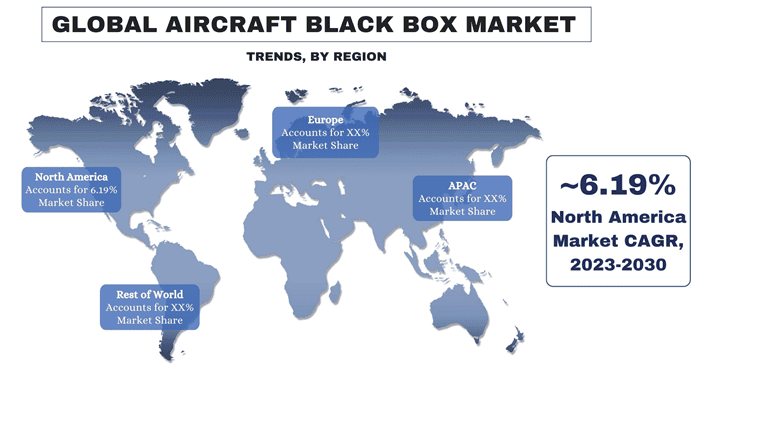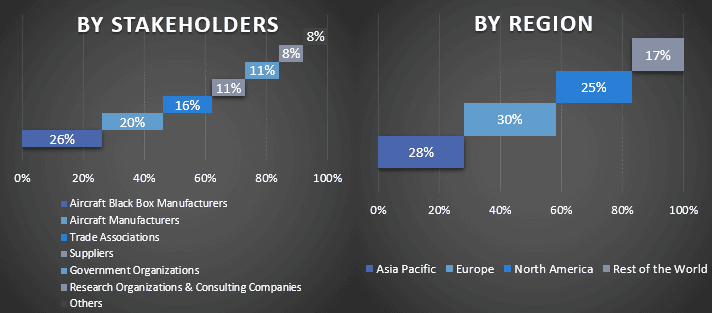- Home
- About Us
- Industry
- Services
- Reading
- Contact Us
Aircraft Blackbox Market: Current Analysis and Forecast (2023-2030)
Emphasis on Type (Flight Data Recorder, and Cockpit Voice Recorder); Application (Commercial and Military) and Region/Country

Aircraft Black Box Market Size & Forecast
The Aircraft Black Box Market was valued at USD 892.83 Million and is expected to grow at a strong CAGR of around 5.9% during the forecast period (2023-2030) owing to rising air traffic worldwide and safety concerns.
Aircraft Black Box Market Analysis
Every air vehicle is required to have a flight data recorder known as a black box. The black box utilizes a specific algorithm to record all flight information. This ensures that the recorded flight data can be accessed by authorities when necessary. Despite common misconception, the black box is predominantly bright orange rather than black. Equipped with voice recording capabilities, these black boxes are considered one of the most exceptional tools in the aviation research industry, particularly due to their ability to withstand extreme situations.
The major factors contributing to the growth of the market include the surge in air traffic, growing government compliances and mandates, and growing technological advancements. The aviation industry has witnessed a continuous drive towards incorporating cutting-edge technologies to enhance flight safety, operational efficiency, and data analysis capabilities. Furthermore, with growing disposable income and tourism, the surge in air traffic has also increased worldwide. For instance, according to the report published by IATA, in 2023, the total traffic, measured in revenue passenger kilometers (RPKs), experienced a significant increase of 36.9% compared to the previous year, 2022, and furthermore, as per Airports Council International, the year 2024 is expected to be a milestone for global passenger traffic recovery as it reaches 9.4 billion passengers, surpassing the year 2019. This has created immense demand for the aircraft black box globally.

Aircraft Black Box Market Trends
Transition to Solid State Black Boxes
The traditional magnetic tape-based black boxes are gradually being replaced by solid-state flight data recorders, which offer enhanced durability, higher data storage capacity, and faster data retrieval. The industry is witnessing a gradual transition from traditional magnetic tape-based black boxes to more advanced solid-state flight data recorders. These next-generation devices offer enhanced durability, higher data storage capacity, and faster data retrieval capabilities, making them better equipped to meet the increasing demands of modern aircraft systems. This transition is driven by the increasing complexity of modern aircraft systems and the need for more comprehensive data recording capabilities. Leading manufacturers, such as L3Harris Technologies and Honeywell, have already unveiled their next-generation solid-state black box solutions, setting the stage for industry-wide adoption.

- L3Harris Technologies, a leading manufacturer, introduced its next-generation solid-state flight data recorder in 2021, offering enhanced durability and data storage capacity.
- Major airlines, such as United Airlines and Emirates, have begun transitioning their fleets to solid-state black boxes, recognizing the advantages they offer over traditional magnetic tape-based systems.
North America Dominated the Aircraft Black Box Market
Within North America, the United States holds a major share of the market. The major factors boosting the market’s growth in the country are the increasing number of commercial and military fleet sizes, government regulations and mandates, growing focus on R&D, a well-established aviation industry, and the presence of several market players.
Safety continues to be of utmost importance for the aviation industry in North America, as continuous efforts are made to reduce accidents and enhance post-accident investigations. Regulatory authorities such as the Federal Aviation Administration (FAA) consistently enhance safety requirements, thereby driving the need for more sophisticated black boxes. An illustrative demonstration of this dedication is evident in a recent FAA regulation (2023) that enforces extended data recording durations (25 hours) for black boxes installed on newly produced small aircraft. Furthermore, the increasing number fleet size has created an unprecedented demand for the Blackbox in the region. For instance, the North America region has the highest number of commercial fleets of 8,468 in 2022 and is expected to reach 9,691 by 2041. The ongoing modernization of aircraft fleets in North America is another factor driving the demand for black boxes.
Aircraft Black Box Industry Overview
The aircraft black box market is competitive and fragmented, with the presence of several global and international market players. The key players are adopting different growth strategies to enhance their market presence, such as partnerships, agreements, collaborations, new product launches, geographical expansions, and mergers and acquisitions. Some of the major players operating in the market are Honeywell International Inc., L3Harris Technologies, Inc., Curtiss-Wright Corporation, Safran, Leonardo S.p.A., Universal Avionics, Teledyne Controls LLC, Elbit System Ltd., Shenzhen Donica Aviation Electronics Co., Ltd., and Garmin Ltd.
Aircraft Black Box Market News
- In 2023, In Aero India, the Hindustan Aeronautics Ltd has received the Indian Technical Standard Order (ITSO) authorization from Directorate General of Civil Aviation (DGCA) for its indigenously developed Cockpit Voice Recorder (CVR) and Flight Data Recorder (FDR).
- In 2022, L3 Harrish Technologies Inc., received Air Transport World’s (ATW) Aviation Technology Achievement award during its 48th Annual Airline Industry Achievement Award Ceremony. L3Harris was recognized for developing and implementing professional Flight Data Monitoring (FDM) into its Airline Academy ab initio flight training. This technology allows instructors and students to mitigate risks and improve safety and training efficiency.
- In 2022, Honeywell unveiled its latest solid-state black box solution, the RESCU406AFN, which boasts advanced crash-survivability features and real-time data streaming capabilities. This innovative product exemplifies the industry’s commitment to embracing cutting-edge technologies to enhance flight safety and operational efficiency.
- In January 2021, ICAO (International Civil Aviation Organization) mandated that all new aircraft designs approved after 2023 must have the capability to transmit real-time location data in the event of an accident.
Aircraft Black Box Market Report Coverage
Report Attribute | Details |
Base year | 2022 |
Forecast period | 2023-2030 |
Growth momentum | Accelerate at a CAGR of 5.9% |
Market size 2022 | USD 892.83 million |
Regional analysis | North America, Europe, APAC, Rest of the World |
Major contributing region | North America dominated the market in 2022 |
Key countries covered | The US., Canada, Germany, The United Kingdom, Spain, Italy, France, China, Japan, and India |
Companies profiled | Honeywell International Inc., L3Harris Technologies, Inc., Curtiss-Wright Corporation, Safran, Leonardo S.p.A., Universal Avionics, Teledyne Controls LLC, Elbit System Ltd., Shenzhen Donica Aviation Electronics Co., Ltd., and Garmin Ltd. |
Report Scope | Market Trends, Drivers, and Restraints; Revenue Estimation and Forecast; Segmentation Analysis; Impact of COVID-19; Demand and Supply Side Analysis; Competitive Landscape; Company Profiling |
Segments Covered | By Type; By Application, and By Region/Country |
Reasons to buy this report:
- The study includes market sizing and forecasting analysis validated by authenticated key industry experts.
- The report presents a quick review of overall industry performance at one glance.
- The report covers an in-depth analysis of prominent industry peers with a primary focus on key business financials, product portfolios, expansion strategies, and recent developments.
- Detailed examination of drivers, restraints, key trends, and opportunities prevailing in the industry.
- The study comprehensively covers the market across different segments.
- Deep dive regional level analysis of the industry.
Customization Options:
The global aircraft black box market can further be customized as per the requirement or any other market segment. Besides this, UMI understands that you may have your own business needs, hence feel free to contact us to get a report that completely suits your requirements.
Table of Content
Research Methodology for the Aircraft Black Box Market Analysis (2023-2030)
Analyzing the historical market, estimating the current market, and forecasting the future market of the global aircraft black box market were the three major steps undertaken to create and analyze the adoption of aircraft black box in major regions globally. Exhaustive secondary research was conducted to collect the historical market numbers and estimate the current market size. Secondly, to validate these insights, numerous findings and assumptions were taken into consideration. Moreover, exhaustive primary interviews were also conducted, with industry experts across the value chain of the global aircraft black box market. Post assumption and validation of market numbers through primary interviews, we employed a top-down/bottom-up approach to forecasting the complete market size. Thereafter, market breakdown and data triangulation methods were adopted to estimate and analyze the market size of segments and sub-segments of the industry pertains to. Detailed methodology is explained below:
Analysis of Historical Market Size
Step 1: In-Depth Study of Secondary Sources:
Detail secondary study was conducted to obtain the historical market size of the aircraft black box market through company internal sources such as annual reports & financial statements, performance presentations, press releases, etc., and external sources including journals, news & articles, government publications, competitor publications, sector reports, third-party database, and other credible publications.
Step 2: Market Segmentation:
After obtaining the historical market size of the aircraft black box market, we conducted a detailed secondary analysis to gather historical market insights and share for different segments & sub-segments for major regions. Major segments are included in the report type and application. Further country-level analyses were conducted to evaluate the overall adoption of testing models in that region.
Step 3: Factor Analysis:
After acquiring the historical market size of different segments and sub-segments, we conducted a detailed factor analysis to estimate the current market size of the aircraft black box market. Further, we conducted factor analysis using dependent and independent variables such as type and application of the aircraft black box market. A thorough analysis was conducted for demand and supply-side scenarios considering top partnerships, mergers and acquisitions, business expansion, and product launches in the aircraft black box market sector across the globe.
Current Market Size Estimate & Forecast
Current Market Sizing: Based on actionable insights from the above 3 steps, we arrived at the current market size, key players in the global aircraft black box market, and market shares of the segments. All the required percentage shares split, and market breakdowns were determined using the above-mentioned secondary approach and were verified through primary interviews.
Estimation & Forecasting: For market estimation and forecast, weights were assigned to different factors including drivers & trends, restraints, and opportunities available for the stakeholders. After analyzing these factors, relevant forecasting techniques i.e., the top-down/bottom-up approach were applied to arrive at the market forecast for 2030 for different segments and sub-segments across the major markets globally. The research methodology adopted to estimate the market size encompasses:
- The industry’s market size, in terms of revenue (USD) and the adoption rate of the aircraft black box market across the major markets domestically
- All percentage shares, splits, and breakdowns of market segments and sub-segments
- Key players in the global aircraft black box market in terms of products offered. Also, the growth strategies adopted by these players to compete in the fast-growing market.
Market Size and Share Validation
Primary Research: In-depth interviews were conducted with the Key Opinion Leaders (KOLs) including Top Level Executives (CXO/VPs, Sales Head, Marketing Head, Operational Head, Regional Head, Country Head, etc.) across major regions. Primary research findings were then summarized, and statistical analysis was performed to prove the stated hypothesis. Inputs from primary research were consolidated with secondary findings, hence turning information into actionable insights.
Split of Primary Participants in Different Regions

Market Engineering
The data triangulation technique was employed to complete the overall market estimation and to arrive at precise statistical numbers for each segment and sub-segment of the global aircraft black box market. data was split into several segments & sub-segments post studying various parameters and trends in the areas of the type and application in the global aircraft black box market.
The main objective of the Global Aircraft Black Box Market Study
The current & future market trends of the global aircraft black box market were pinpointed in the study. Investors can gain strategic insights to base their discretion for investments on the qualitative and quantitative analysis performed in the study. Current and future market trends determined the overall attractiveness of the market at a regional level, providing a platform for the industrial participant to exploit the untapped market to benefit from a first-mover advantage. Other quantitative goals of the studies include:
- Analyze the current and forecast market size of the aircraft black box market in terms of value (USD). Also, analyze the current and forecast market size of different segments and sub-segments.
- Segments in the study include areas of the type and application.
- Define and analysis of the regulatory framework for the aircraft black box
- Analyze the value chain involved with the presence of various intermediaries, along with analyzing customer and competitor behaviors of the industry.
- Analyze the current and forecast market size of the aircraft black box market for the major region.
- Major countries of regions studied in the report include Asia Pacific, Europe, North America, and the Rest of the World
- Company profiles of the aircraft black box market and the growth strategies adopted by the market players to sustain in the fast-growing market.
- Deep dive regional level analysis of the industry
Frequently Asked Questions FAQs
Q1: What is the current market size and growth potential of the aircraft black box market?
Q2: What are the driving factors for the growth of the aircraft black box market?
Q3: Which segment has the largest share of the aircraft black box market by type?
Q4: What are the emerging technologies and trends in the aircraft black box market?
Q5: Which region will dominate the aircraft black box market?
Related Reports
Customers who bought this item also bought










